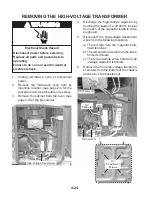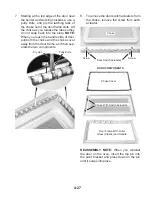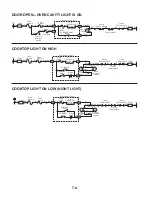
5-1
COMPONENT TESTING
Electrical Shock Hazard
Disconnect power before servicing.
Replace all parts and panels before operating.
Failure to do so can result in death or electrical shock.
IMPORTANT:
Before performing any tests on
the microwave oven, be sure to observe the
following:
Unplug microwave oven or disconnect
•
power.
Remove the lead wires from the related
•
component before conducting any of the
following tests.
All operational checks using microwave en-
•
ergy must be done with the microwave oven
loaded with a minimum of 10 oz. (300 mL)
of water in a microwave-safe container.
Conduct a microwave energy test af-
•
ter performing any tests or repairs to the
microwave oven.
Check that all wire leads are in the correct
•
position before operating the microwave
oven.
Grasp wire connectors when removing the
•
wire leads from microwave oven parts.
All testing must be done with an ohmmeter
•
having a sensitivity of 20,000 ohms-per-
volt DC or greater and powered by at least
a 9-volt battery.
THERMOSTATS
Refer to the following pages for the procedures
for accessing the thermostats:
Cavity Thermostat #3, page 4-5
Cavity Thermostat #2, page 4-9
Cavity Thermostat #1, page 4-12
Magnetron Thermostat, page 4-18
Exhaust Fan Thermostat, page 4-19
WARNING
1. Unplug microwave oven or disconnect
power.
2. Disconnect one of the wires from the
thermostat terminals.
3. Set the ohmmeter to the R x 1 scale.
4.
Exhaust Fan Thermostat:
Touch the ohm-
meter test leads to the thermostat termi-
nals. The meter should indicate an open
(infinite) circuit.
5.
All Other Thermostats:
Touch the ohm-
meter test leads to the thermostat termi-
nals. The meter should indicate a closed
(0
Ω
) circuit.
















































